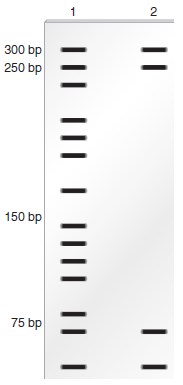
Genetics: Analysis and Principles 5th Edition by Robert Brooker
Edition 5ISBN: 978-0073525341
Genetics: Analysis and Principles 5th Edition by Robert Brooker
Edition 5ISBN: 978-0073525341 Exercise 44
The technique of DNA footprinting is described in Chapter 20. If a protein binds over a region of DNA, it will protect the DNA in that region from digestion by DNase I. To carry out a DNA foot-printing experiment, a researcher has a sample of a cloned DNA fragment. The fragments are exposed to DNase I in the presence and absence of a DNA-binding protein. Regions of the DNA fragment not covered by the DNA-binding protein will be digested by DNase I, producing a series of bands on a gel. Regions of the DNA fragment not digested by DNase I (because a DNA-binding protein is preventing DNase I from gaining access to the DNA) will be revealed, because a region of the gel will not contain any bands.In the DNA footprinting experiment shown here, a researcher began with a sample of cloned DNA 300 bp in length. This DNA contained a eukaryotic promoter for RNA polymerase II. For the sample loaded in lane 1, no proteins were added. For the sample loaded in lane 2, the 300-bp fragment was mixed with RNA polymerase II plus TFIID and TFIIB. 
a. How long of a region of DNA is "covered up" by the binding of RNA polymerase II and the transcription factors
B. Describe how this binding would occur if the DNA was within a nucleosome structure. (Note: The structure of nucleosomes is described in Chapter 10.) Do you think that the DNA is in a nucleosome structure when RNA polymerase and transcription factors are bound to the promoter Explain why or why not.

a. How long of a region of DNA is "covered up" by the binding of RNA polymerase II and the transcription factors
B. Describe how this binding would occur if the DNA was within a nucleosome structure. (Note: The structure of nucleosomes is described in Chapter 10.) Do you think that the DNA is in a nucleosome structure when RNA polymerase and transcription factors are bound to the promoter Explain why or why not.
Explanation
In the process of DNA footprinting, the ...
Genetics: Analysis and Principles 5th Edition by Robert Brooker
Why don’t you like this exercise?
Other Minimum 8 character and maximum 255 character
Character 255



